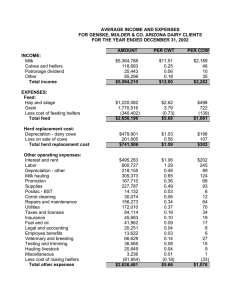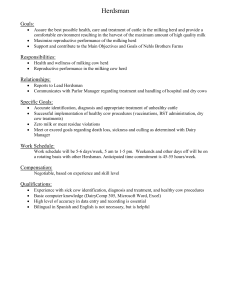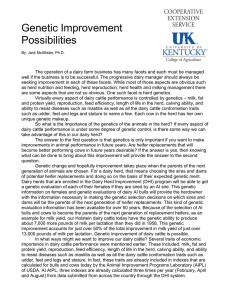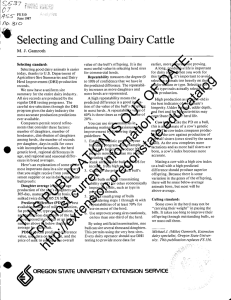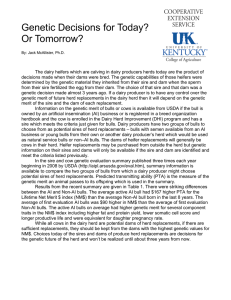Why Measure?
advertisement
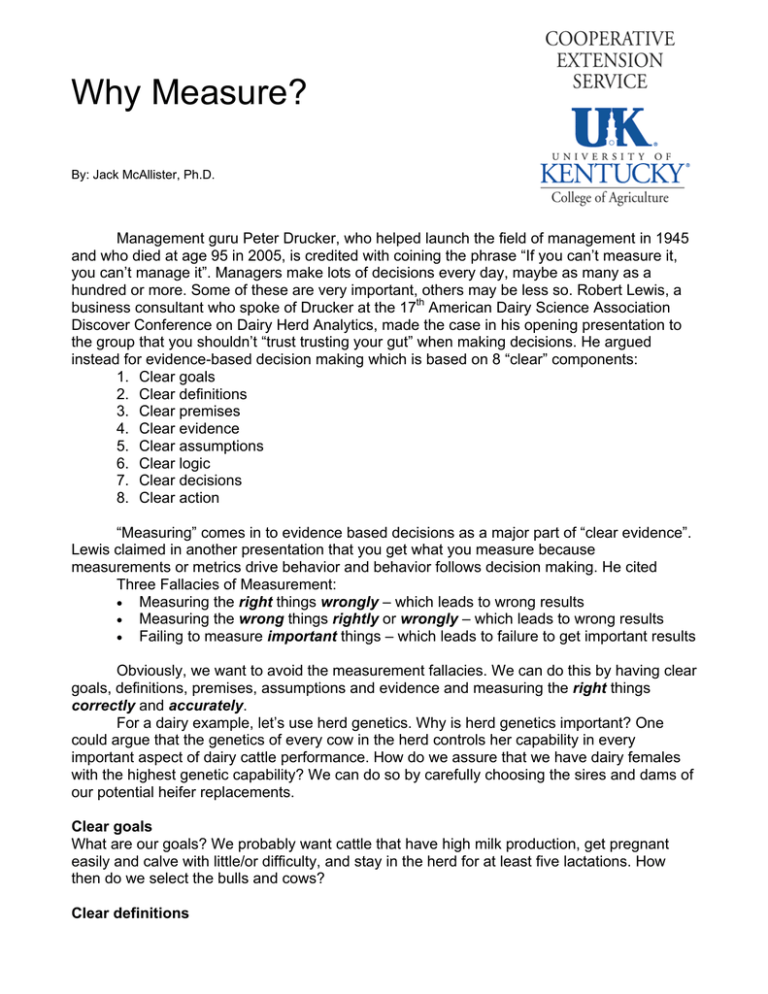
Why Measure? By: Jack McAllister, Ph.D. Management guru Peter Drucker, who helped launch the field of management in 1945 and who died at age 95 in 2005, is credited with coining the phrase “If you can’t measure it, you can’t manage it”. Managers make lots of decisions every day, maybe as many as a hundred or more. Some of these are very important, others may be less so. Robert Lewis, a business consultant who spoke of Drucker at the 17th American Dairy Science Association Discover Conference on Dairy Herd Analytics, made the case in his opening presentation to the group that you shouldn’t “trust trusting your gut” when making decisions. He argued instead for evidence-based decision making which is based on 8 “clear” components: 1. Clear goals 2. Clear definitions 3. Clear premises 4. Clear evidence 5. Clear assumptions 6. Clear logic 7. Clear decisions 8. Clear action “Measuring” comes in to evidence based decisions as a major part of “clear evidence”. Lewis claimed in another presentation that you get what you measure because measurements or metrics drive behavior and behavior follows decision making. He cited Three Fallacies of Measurement: Measuring the right things wrongly – which leads to wrong results Measuring the wrong things rightly or wrongly – which leads to wrong results Failing to measure important things – which leads to failure to get important results Obviously, we want to avoid the measurement fallacies. We can do this by having clear goals, definitions, premises, assumptions and evidence and measuring the right things correctly and accurately. For a dairy example, let’s use herd genetics. Why is herd genetics important? One could argue that the genetics of every cow in the herd controls her capability in every important aspect of dairy cattle performance. How do we assure that we have dairy females with the highest genetic capability? We can do so by carefully choosing the sires and dams of our potential heifer replacements. Clear goals What are our goals? We probably want cattle that have high milk production, get pregnant easily and calve with little/or difficulty, and stay in the herd for at least five lactations. How then do we select the bulls and cows? Clear definitions Our measure of the genetic merit of the bulls and cows are their genetic evaluations available from the Animal Improvement Programs Laboratory of the United States Department of Agriculture ( www.aipl.arsusda.gov ). Every AI or registered dairy bull with progeny and every dairy cow enrolled in the Dairy Herd Improvement (DHI) program which is either registered or has an AI sire receives a genetic evaluation. Thus, genetic evaluations are available on the following traits and indexes: milk yield, fat yield, fat percentage, protein yield, protein percentage, productive life, somatic cell score, daughter pregnancy rate, Net Merit $ Index, Fluid Merit $ Index and Cheese Merit $ Index. Each of these traits and indexes are clearly defined. Clear premises Our premise is that each sperm and each egg contain a random sample of the genes possessed by each animal that produces them. Clear evidence Our evidence is the published genetic evaluations of the bulls and cows. Clear assumptions Our assumption is that calves receive a random sample half of the genes each from the sire and dam which were transmitted in the sperm and egg which united to form them. Clear logic Our logic is that the genetic merit of a calf is the average of the genetic merit of their sire and their dam. Clear decision Our decision then is to decide which AI bull to mate to which cow to produce an offspring. Clear action Our action is to detect the chosen cow when she is in heat and inseminate her with semen from the chosen bull. If we followed the process outlined above I would argue that we have used measurements to guide our decisions and taken action to help us effectively manage the genetics of our dairy herd. Educational programs of Kentucky Cooperative Extension serve all people regardless of race, color, age, sex, religion, disability, or national origin.




